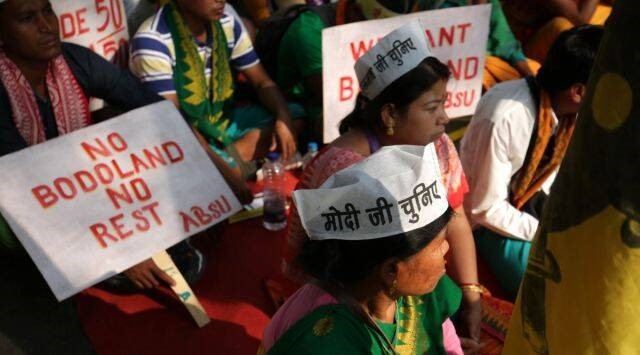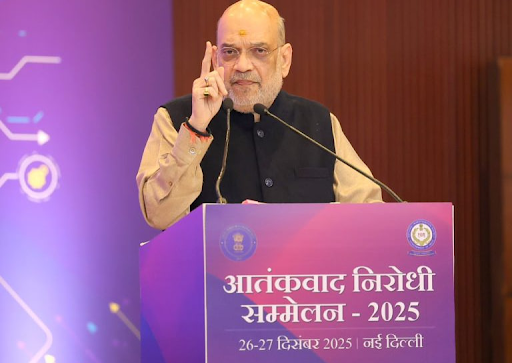Description

Disclaimer: Copyright infringement not intended.
Context
- After the government signed a peace settlement with the Dimasa National Liberation Army (DNLA), both Union Home Minister Amit Shah and Assam Chief Minister Himanta Biswa Sarma declared that it marked the end of the tribal insurgency in Assam.
Background
- This was a significant claim for a state which — even after Nagaland, Mizoram, Meghalaya, and Arunachal Pradesh were carved out of it — has seen insurgency by various tribal militant groups, particularly from the 1980s onwards.
- The core demand of most of these groups has been greater political autonomy, primarily through separate statehood demands.
Location
- Located in the strategic northeastern corner of India, it is part of a region which shares a highly porous and sensitive frontier with China in the North, Myanmar in the East, Bangladesh in the Southwest and Bhutan to the Northwest.
- Spread over 2,62,179 sq. km, the strategic importance of Northeast India can be determined from the fact that it shares a 4,500 km-long international border with four South Asian neighbours but is connected to the Indian mainland by only a tenuous 22 km-long land corridor passing through Siliguri in the eastern state of West Bengal.
Ethnicity
- The northeastern region is also an ethnic minefield, as it comprises of around 160 Scheduled Tribes, besides an estimated 400 other tribal or sub-tribal communities and groups.
- Turbulence in India‘s Northeast is, therefore, not caused just by armed separatist groups representing different ethnic communities fighting the central or the local governments or their symbols to press for either total independence or autonomy, but also by the recurring battles for territorial supremacy among the different ethnic groups themselves.

Origin
- Insurgency began in Assam with the birth of the United Liberation Front of Asom (ULFA) in 1979.
- On 7 April 1979, six radical Assamese youths met at the Rang Ghar, the famous amphitheatre of the Ahom royalty and formed the ULFA, vowing to fight against the ―colonial Indian Government with the ultimate aim to achieve a ―sovereign, socialist Assam.
- they agreed that the Indian state has been ―exploiting Assam‘s rich tea, oil and forest resources without benefiting the people of Assam.
- The late 80s witnessed ULFA‘s influence in Assam reaching new heights. Rebels of the outfit killed, kidnapped and threatened tea planters and businessmen in the State to procure funds to purchase weapons and to send its cadres for advanced training in Myanmar, Afghanistan and other places.
- A reign of terror prevailed as ULFA assassinated and threatened businessmen and industrialists across the State.
- In 1990, the governance in Assam broke down which led to declaration of President‘s rule in the State with a subsequent ban on the ULFA.
The agreements
Tribes in Assam
- There are 15 recognised tribes in the autonomous districts of Karbi Anglong and North Cachar Hills and 14 recognised tribes in the rest of the state.
- Of these, the major tribes are Bodo (35% of the state’s tribal population), Mishing (17.52%), Karbi (11.1%), Rabha (7.6%), Sonowal Kachari (6.5%), Lalung (5.2%), Garo (4.2%), and Dimasa (3.2%).
- Of these, the most sustained and violent movement for autonomy has been carried out by Bodo groups, but there have also been Karbi and Dimasa groups that waged militant operations over the decades.
- The peace process has been a long one and the claim of ending insurgency in tribal areas comes after a string of peace settlements with different groups in recent years.
Bodo
- While the first organised demand for a separate Bodo state emerged in the 1960s, it revived and gained strength through the All Bodo Students’ Union (ABSU) after the signing of the Assam Accord in 1985.
|
ASSAM ACCORD
- Assam Accord was a Memorandum of Settlement (MoS) signed between representatives of the Government of India and the leaders of the Assam Movement.
- It was signed in the presence of the then-Prime Minister Rajiv Gandhi in New Delhi on 15 August 1985.
- It followed a six-year agitation that started in 1979. Led by the All Assam Students’ Union (AASU), the protestors demanded the identification and deportation of all illegal foreigners – predominantly Bangladeshi immigrants.
- The leaders of the Assam Movement agreed to accept all migrants who had entered into Assam prior to 1 January 1966.
- The Government of India acknowledged the political, social, cultural and economic concerns of the Assamese people and agreed to revise the electoral database based on that date.
- Further, the government agreed to identify and deport any and all refugees and migrants after March 25 1971.
|
- The first Bodo Accord was signed with the ABSU in 1993 and paved the way for the Bodoland Autonomous Council. But this fell through when the ABSU withdrew from it and revived the demand for a separate state.
- The second Accord in 2003 with the Bodo Liberation Tigers subsequently led to the formation of the Bodo Territorial Council (BTC), with jurisdiction over the Bodo Territorial Autonomous District (BTAD).
- The third Bodo Accord of 2020 was essentially a truce with four factions of the militant National Democratic Front of Bodoland. It extended provisions already in effect through the previous accords by providing more legislative, administrative, executive and financial powers to the BTC; the power to alter the area of the BTAD; and the notification of the Bodo language as an associate official language in the state.
Karbi
- In 2021, a settlement was arrived at with five militant groups of Karbi Anglong that was said to have brought Karbi insurgency to an end.
- The insurgency by Karbi groups, too, revolved around the demand for an autonomous state and had taken off in the 1980s.
- In 2011, the United People’s Democratic Solidarity signed a tripartite settlement with the Union and Assam governments that provided for greater autonomy and special packages for the Karbi Anglong Autonomous Council.
- The 2021 settlement further granted more autonomy and provided a special development package of Rs 1,000 crore over five years.
Dimasa
- The DNLA, with which a tripartite agreement was reached, was the newest group to take up arms in Dima Hasao district.
- The settlement signed with the DNLA now has similar provisions along the lines of the settlement arrived at with the five Karbi Anglong groups two years ago.

Concluding remarks
- While settlements with all active tribal militant groups have been arrived at in recent years, history has seen breakaway factions and new groups crop up after negotiations with a given group or a section of the leadership of a group.
- Caution should be exercised as the possibility of other groups coming to the fore remains open.
- New Delhi must set up a North East Security Council to both comprehend and administer the region holistically.
- The biggest challenge for the government remains the Paresh Baruah-led ULFA (I), which continues to hold fast to the demand for sovereignty.
MUST READ ARTICLES:
About Insurgency in North-east:
https://www.iasgyan.in/ig-uploads/pdf/RSTV_End_of_the_Road_for_Northeast_Insurgency.pdf
|
PRACTICE QUESTION
Q) While settlements with all active tribal militant groups in North-east have been arrived at in recent years, history has seen breakaway factions and new groups crop up after negotiations with a given group or a section of the leadership of a group. Analyse. (250 words)
|

https://indianexpress.com/article/political-pulse/smoking-the-peace-pipe-assam-bodo-karbi-dimasa-tribal-insurgencies-8584077/










